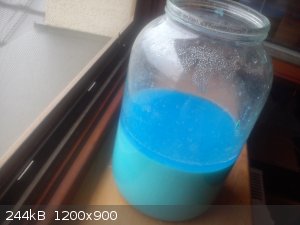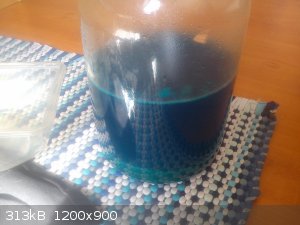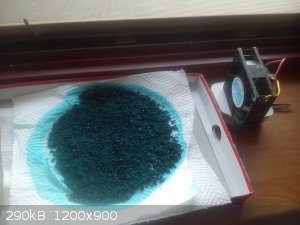
Fidelmios - 27-8-2016 at 00:27
Hey again all,
So I was doing some of my crystallizations, and I am using up my supply of 10 lbs of copper sulfate. Now I wanted to use about 300g and make a
sizeable crystal of copper acetate, but I ran into a slight issue. Most of the syntheses I see online are from elctrolysis of copper metal or copper
carbonate with vinigar. Making copper carbonate isn't a problem for me, in fact I think this method improves my purity due to Seed Ranch's fairly poor
purity of this sample. I was just curious if directly adding the vinigar to the copper sulfate was a viable option, or would it introduce some more
impurities.
P.s. if you've got a way to purify 10 lbs of copper sulfate... ten points to Ravenclaw.
crystal grower - 27-8-2016 at 04:13
CH3COOH + CuSO4 = H2SO4 + Cu(CH3COO)2
This reaction won't work at all. Acetic acid is a very weak acid and it simply can't react with salt of a such strong acid.
You could make CH3COONa and react it with CuSO4 becouse sodium acetate is a base and CuSO4 is mildly acidic. But all u will get as a result is a
mixture of copper acetate and sodium sulfate which isnt so easy to split.
I would recommed u making copper carbonate first and then react it with vinegar, it's pretty easy route just be carefull enough so you dont have to
clean whole table because of spilled reagents . (I know what Im talking about
. (I know what Im talking about ).
).
diddi - 27-8-2016 at 04:15
purify your sulfate by precipitating the basic copper carbonate. easy to add a bunch of bicarbonate for that. ensure you wash your solid carefully
with distilled water.
then use good acetic acid. vinegar is full of rubbish that will affect nice crystal growth. I made some recently and they turned out very well
coloured and shaped (but not very big due to scale)
Romain - 27-8-2016 at 05:05
If you have access to sodium hydroxide, you might want to make copper oxide by adding a slight excess of sodium hydroxide to copper sulfate and
boiling the solution until the blue color disappears. Copper hydroxide decomposes to copper oxide when heated and I find it is easier to filter and
wash copper oxide than it is with copper carbonate.
Copper oxide then reacts with acetic acid to produce copper acetate.
Neme - 27-8-2016 at 05:33
I have made about 480grams of copper acetate from copper sulphate without electrolysis, but unfortunately, I don't remember amounts of reactans. This
is my route:
Items needed:
*containers
*copper sulphate
*sodium carbonate
*acetic acid
*filter apparatus
1) I took 4l jar and dissolved copper sulphate in it.
2) I kept adding sodium carbonate slowly. This is needed to do very slowly, because of the amount of gas produced.
3) The color of copper sulphate solution was fading out as the copper sulphate reacted.
4) I left the product settle, it looked like this:
 image 1
image 1
you can see that I did not add enough sodium carbonate to react all copper sulphate. It's kind of waste, but I used all of my sodium carbonate and I
was too lazy to go to shop for another.
5) Now filtration, it takes a lot time and effort to filter such amount of precipitate so be prepared.
6) I washed the product well.
7) I started adding acetic acid to product, again slowly because of the CO2 produced.
8) Even after excess of acetic acid, not all copper carbonate reacted so I heated it to react completedly.
 image 2
image 2
9) Filtered again and crystalized out. Pure product here:
 image 3
image 3
I hope I didn't forget a step or anything, it's been quite I while, since I did that.



Fidelmios - 1-9-2016 at 00:32
So I went about Neme's method, in a much smaller amount, and with a much larger amount of Acetic Acid. I wanted to get the product asap, and as
mentioned my Copper Sulfate keeps showing signs of impurity, so I just used Cleaning Vinegar from Walmart. Noted on the bottle was only Acetic Acid
and water, so no soaps, no surfactants.
So in my container I had a fair amount of Copper Acetate in an excess of Acetic acid and water. I've been driving off the aqueous stuff in the
microwave, and it was bubble far too much, and I noticed some little string like, brown scuzzy stuff floating inside. I've decided to rapidly
evaporate off my solvent under my fan overnight. Will update in the morning!
Fidelmios - 5-9-2016 at 20:20
okay so I used a fan to evaporate off the excess Water and Acetic Acid. Most of it is gone, but I've got the deep blue/black color of the salt. I
think I'll evap off the rest of the fluid and then recrystallize.

 . (I know what Im talking about
. (I know what Im talking about ).
).